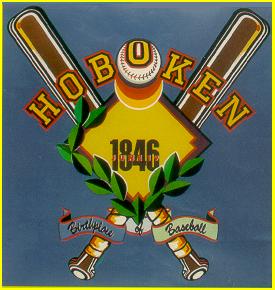 |
 Hoboken and the Beginnings of Baseball
Hoboken and the Beginnings of Baseball
By Nicholas Acocella
Part 4 - The Development of the Game
By 1858, there were, in the New York area, 60 organized clubs playing under Cartwright's rules. That same year, patrons were asked for the first time to cough up the price of a ticket: 50 cents for each of three all-star matches, between teams made up of the best players from Brooklyn and New York City, played at the Fashion Race Track in Long Island. Four years later, an entrepreneur named William Cammeyer built the first enclosed baseball park, Union Grounds in Brooklyn, and charged admission on a regular basis. From there it was only a short hop to a demand by players for a share of the gate; a series of quick skips to playing players under the table, the creation of the all-professional Cincinnati Red Stockings in 1869, and the end of baseball as a gentlemanly amateur recreation; and a middling jump to multi-million dollar, long term, no-cut contracts.
While the New York Club disappeared from history soon after the 1846 game, the Knickerbockers continued to play intramural matches. Their next match game was on June 3, 1851, when they defeated the Washington Club 21-11 at the Red House Grounds in Harlem. Later, the Knickerbockers became one of the bulwarks of the National Association of Base Ball Players, the governing body of amateur baseball from 1857 to 1869, Their sporty uniforms of blue woolen pantaloons, white flannel shirts, and straw hats became familiar reminders of the club's historical primacy.
The Knickerbocker Club resolutely resisted charging admission to games, however. Clinging to its amateur status until 1882, the club eventually foundered on its opposition to professionalism. (The once profane James Whyte Davis, who became a member of the Knickerbockers after the demise of the New York Club, had obviously mended his ways, and, with age, adopted a redoubtable moralistic stance: He resigned from the Knickerbockers in 1870 in protest over the club's compromise of participating in games at which admission was charged, even though it refused to accept any of the gate receipts.) Nevertheless, the effort to keep baseball the private preserve of gentlemen and amateurs was doomed from the moment the first fan stepped up to the ticket booth at the Fashion Race Track and put down his four bits.
Elysian Fields continued to be used for ball games for some years. In 1859, eight clubs used its facilities on a regular basis. In the same year, a cricket match between the United States and England attracted 24,000 spectators to the site. And, on October 21, 1861, Brooklyn and New York all-star teams met there before a crowd of 15,000 (Brooklyn won 18-6.) The United States government acquired the site in 1917 and turned what had been an idyllic park into a collection of war-related warehouses. The Maxwell House division of General Foods acquired the property in 1938.
Cartwright himself was long gone from New York even before the game he codified had spread even as far as Philadelphia or Boston. In 1849, he joined the rush to the California gold fields, and, in 1852, he moved on to Hawaii for his health. But his pioneering included a role as baseball missionary. Traveling overland, he organized baseball games along the way, using as players -- a spectacle to be imagined with relish -- mountain men and Native Americans, as well as traveling companions. He also introduced baseball on what were then the Sandwich Islands. He died in 1892, one of Honolulu's leading bankers and merchants, the founder of the city's library and its fire department, and the manager of the Hawaiian royal family's finances.



|
|
 |